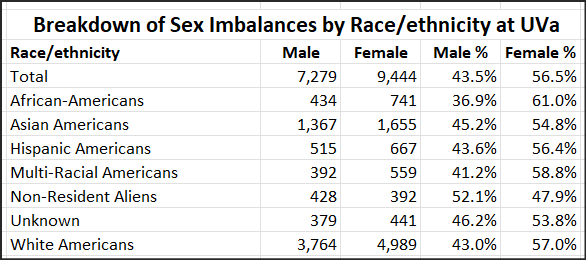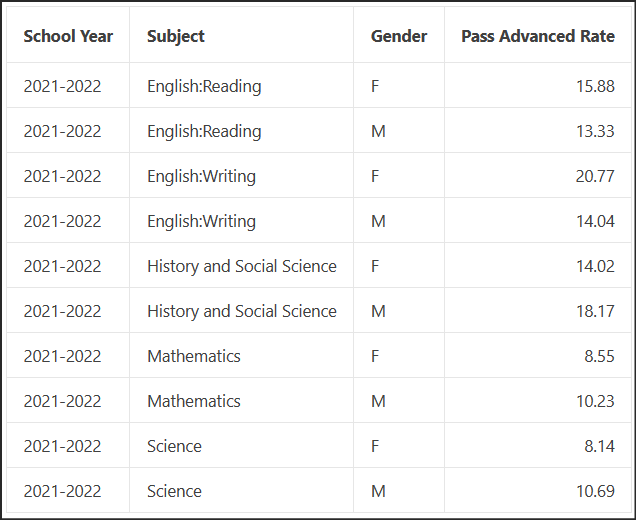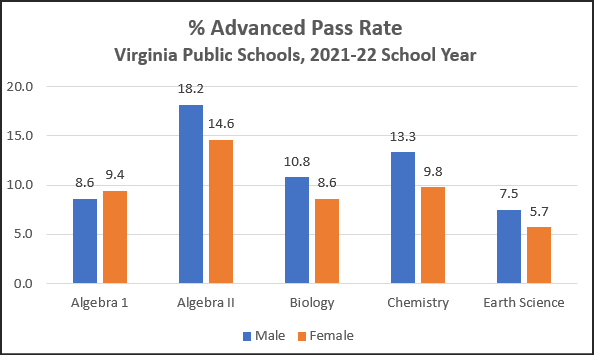
by James A. Bacon
Diversity, Equity & Inclusion at the University of Virginia is incoherent in theory, arbitrary in practice, and riddled with contradictions. Nowhere is DEI policy more muddled than UVa’s treatment of men and women. UVa’s long-term goal is to recruit a student body that “looks like Virginia” in its racial/ethnic composition. Yet UVa leadership has expressed no qualms about the persistent imbalance of men and women.
Among UVa’s 16,700+ undergraduate students, 54.5% were female and only 45.5% were male — a nine percentage-point differential. The disparity exists across racial/ethnic groups. Only among foreign students are males enrolled in a slightly higher percentage than females.
Why does the disparity exist? Given the university’s commitment to “equity,” why isn’t the ratio close to 50/50? UVa officials never talk about the gender enrollment gap, which is not surprising given that the disparity cuts against the oppression narrative that undergirds the university’s Diversity, Equity & Inclusion initiatives. To the contrary, university officials are in a state of perpetual angst over the fact that some disciplines, particularly engineering and the sciences, enroll more men than women. Yet no one is distressed about insufficient male enrollment in the social sciences and humanities.
Outsiders are left to speculate about the reasons. A benign explanation for UVa’s 55/45 ratio is that there are more female applicants to UVa, or that female applicants are just better qualified. It’s hard for outsiders to get straight answers because the publicly available data are fragmentary.
UVa doesn’t release SAT and ACT scores, and it has made them optional in any case, so there is no objective data regarding the academic qualifications of UVa’s undergraduate students. However, 2/3 of UVa’s undergraduates are Virginia residents, a majority of them attended public high school, and the Virginia Department of Education (VDOE) provides extensive data on K-12 public school students’ Standards of Learning pass rates. Therefore, it is possible to compare the academic qualifications of the pool of high school students that UVa draws from.
VDOE divides pass rates on SOL exams into “proficient” and “advanced.” As UVa is Virginia’s flagship university with the highest admissions standards (running neck and neck with the College of William and Mary), I queried the VDOE build-a-table database to obtain the “advanced” pass rate for males and females in the five main subject areas: English reading, English writing, math, science, and history/social studies. Here are the results for all K-12 grades (in percentages):

A significantly larger percentage of girls score “advanced” in English reading and writing, while more boys score “advanced” in math, science, and history/social science. Tally up the percentages in all subjects, and you get 67.4 for girls and 67.1 for boys, with girls clearly possessing superior language skills and boys clearly possessing superior math skills.
Does that pattern hold in 11th and 12th grades when high school kids are thinking about college?
VDOE tracks English and Writing scores only through 8th grade, but it breaks out numbers for high-school courses including algebra, geometry, biology, chemistry and earth science. At least for math and sciences, the pattern of superior male performance that we see in lower grades persists in high school. It is likely that the pattern of superior female performance in languages does as well.

This pattern is consistent with national SAT scores in which a greater percentage of females receive high scores in English and writing, and males score higher in math. In the combined english+math range of scores from which UVa has traditionally drawn most of its students from (1200 to 1600 points) males actually outperform females nationally — 18% compared to 15%. (Males also appear in greater percentages among the lowest scores, while females are more likely to cluster in the middle ranges.)
Based on this data, it is reasonable to conclude that the pool from which UVa draws 2/3 of its students shows that girls and boys are roughly equal in overall aptitude, with girls more likely on average to excel in verbal skills and boys in spatial reasoning. The pool of high school students with strong academic aptitudes that UVa draws from has rough gender parity between females and males.
That’s not the end of the story. Admissions officials look for more than academic aptitude. They value non-academic accomplishments such as sports, engagement in student groups, and activity outside school. According to twenty-year-old U.S. Census data, teenage girls were more likely to join clubs than boys by a 29% to 24% margin, while boys were more likely to participate in sports by a 44% to 29% margin. Participation in non-academic activities seems to be a wash.
If UVa can show data to show that female applications are more qualified overall their male counterparts, I am willing to stand corrected. Given the death grip UVa officials maintain over their admissions data, however, I don’t see that happening in the foreseeable future.
What other explanations could there be? One would be a systemic bias in favor of females over males. Such a bias can be seen in the composition of the university’s Diversity, Equity & Inclusion staff, which is disproportionately women. In a recent column, Bacon’s Rebellion columnist Jim Sherlock provides the following data points: The Office of Undergraduate Admissions lists three males and 13 females. The Office of Equal Opportunity and Civil Rights. (OEOCR) lists one male and seven females.
I would suggest that anti-male bias permeates university culture. It can be seen from the laudatory attention given females in UVA Today profiles to the awarding of rooms on the Lawn and the hostility toward Greek life, especially fraternities. I will endeavor to document those biases in future posts.
Additionally, there are instances of clear bias in the awarding of scholarships and awards, and in the administration of Title IX (sexual assault and sexual harassment) cases. I’ll provide details in a follow-up post.
In sum, the disparate numbers for men and women call out for explanation. UVa officials have been remarkably silent on the topic. Absent a reasonable explanation, the rhetoric about “equity” and “equality of opportunity” rings hollow. Some groups, it would appear, warrant special consideration while others do not.


